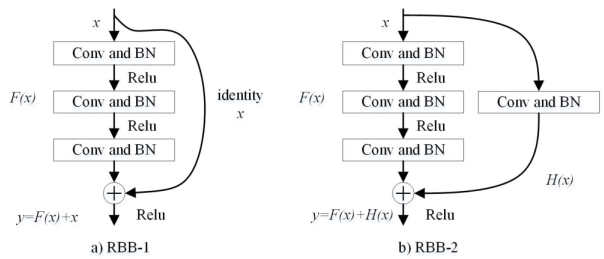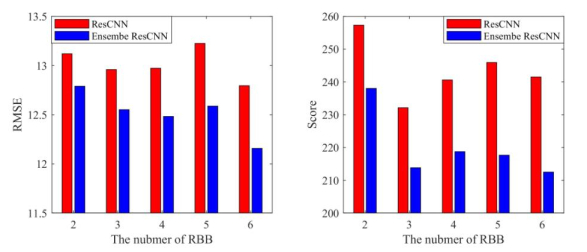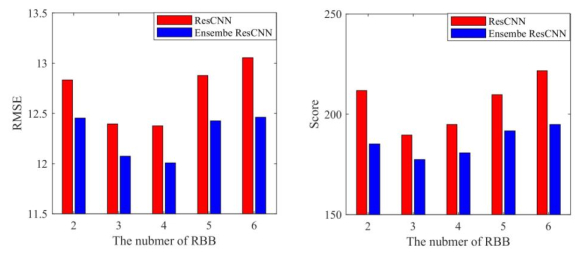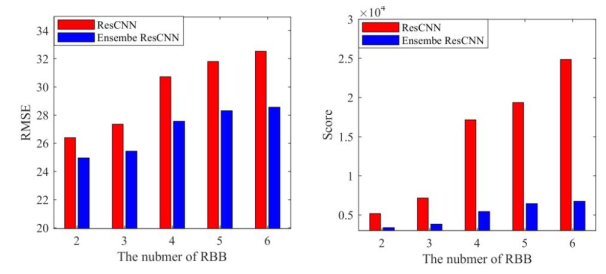Remaining useful life (RUL) estimation is one of the most important component in prognostic health management (PHM) system in modern industry. It defined as the length from the current time to the end of the useful life. With the rapid development of the smart manufacturing, the data-driven RUL approaches have been widely investigated in both academic and engineering fields. Deep learning, which is a new paradigm in machine learning, has been applied in the RUL related fields, and has achieved remarkable results. However, classical deep learning algorithms also encounter the vanishing/exploding gradient problem found in artificial neural network with gradient-based learning methods and backpropagation. In this research, a new residual convolutional neural network (ResCNN) is proposed. ResCNN applies the residual block which skips several blocks of convolutional layers by using shortcut connections, and can help to overcome vanishing/exploding gradient problem. What's more, the ResCNN is enhanced by using the k-fold ensemble method. The proposed ensemble ResCNN is conducted on the C-MAPSS data provided by NASA. The results show that the proposed ensemble ResCNN has achieved significant improvement in both the mean and the standard deviation of the prediction RUL values. The proposed ensemble ResCNN has also compared with other famous machine learning and deep learning methods, including Multilayer Perceptron, Support Vector Machines, Deep Belief Networks, Long Short-Term Memory Model, Convolutional Neural Network and many other methods in literatures. The comparison results show that ensemble ResCNN achieved the start-of-the-art results, and outperform almost all of them.
1.
Introduction
Prognostic health management (PHM) system is vital in modern industry and it has been widely applied in civil aerospace, automobile, and manufacturing. PHM can detect the failures which may occur in systems due to aging or unexpected incidents and provide valuable warning to avoid dangerous situations [1]. The goals of PHM are to reduce such risks and improve the safety and reliability of the systems. Remaining useful life (RUL) is defined as the length from the current time to the end of the useful life [2]. RUL estimation is one of the indispensable component in PHM. By taking RUL estimation technique, the industries can take more accurate maintenance actions and reduce the maintenance costs. The RUL estimation has been widely investigated by researchers from both academic and engineering fields [3].
In generally, the RUL prediction methods could be roughly classified as model-based, data-driven and hybrid methods [4]. With the rapid development of the smart manufacturing, the data can be collected more conveniently, the data-driven RUL methods have received increasing attentions [5]. The data-driven RUL approaches can learn the knowledge of system using collected historic data to predict RUL. As most engineering systems are complicated, it is difficult to model their model-based degradation processes, the data-driven RUL estimation is very suitable for these complicate systems.
Data-driven RUL estimation methods usually use machine learning techniques to establish the degradation processes of the machinery [6,7,8,9], such as artificial neural network (ANN), support vector machine (SVM), and neuro-fuzzy system. Ali et al. [5] investigated the RUL of bearings using Weibull distributions, and the parameters of Weibull distribution is optimized by ANN. Daroogheh et al. [10] studied the integration of Particle filters (PFs) and ANN based health condition prediction method for gas turbine engine. Huang et al. [11] applied self-organizing map (SOM) to build the degradation indicator and trained a back-propagation ANN to predict the degradation periods. Khelif et al. [12] applied SVM to learn the direct relation between sensor values and degradation process, and it was evaluated on the Turbofan dataset. The results showed that the performance of the proposed method is competitive. Ordóñez et al. [13] applied auto-regressive integrated moving average (ARIMA) to estimate the values of the predictor variables as the input of a support vector regression model (SVM) to train the RUL models. Huang et al. [14] surveyed the SVM base estimation of RUL. He divided these methods into two types: 1) to predict the condition state in advance and then build a relationship between state and RUL; 2) to establish a direct relationship between current state and RUL. Wu et al. [15] studied a multi-sensor information fusion system for online RUL prediction of machining tools, and an adaptive network based fuzzy inference system (ANFIS) model was built for RUL prediction. Chen et al. [16] investigated ANFIS and high-order PF based prognostic model, and this model was evaluated using the testing data from a cracked carrier plate and a faulty bearing. Mathew et al. [17] selected ten machine learning algorithms to predict the RUL of aircraft's turbo fan engine.
In most data-driven RUL methods, there are three main steps: 1) fault signal acquisition; 2) feature extraction and selection from fault signals; and 3) RUL prediction. Signal acquisition process is the basis of data-driven RUL methods. In the feature extraction and selection process, either complicated signal processing techniques or priori knowledge of the system is necessary to extract the most significant handcrafted features. These handcrafted features have a great effect on the final machine learning methods. Deep learning (DL), which emerges as a new paradigm in machine leaning field, has provided an attractive opportunity to handle with historic data. With this advantage, the application of DL to RUL have been investigated by many researchers.
The key of deep learning is that it can learn discriminative features via multiple levels of representation in an automatic way [18]. Lei et al. [3] summarized the survey on the data acquisition, health indicator (HI) construction, health stage (HS) division, and RUL prediction. Zhao et al. [19] surveyed the DL methods for data-driven machine health monitoring. Deutsch and He [20] proposed a DBN-feedforward neural network (FNN) algorithm which took deep belief network (DBN) to extract the data features as the data-preprocess of FNN. Deutsch et al. [21] studied the DBN with PFs method for the RUL prediction of hybrid ceramic bearings. The method was on the real data collected from hybrid ceramic bearing run-to-failure tests. Zhang et al. [22] proposed a multi-objective DBN for the RUL estimation. He employed a multi-objective evolutionary algorithm to train multiple DBNs considering accuracy and diversity as two conflicting objectives simultaneously, and experimental results demonstrated the superiority of this method. Ma et al. [1] investigated a DBN based health status assessment method on gas turbine engine, and the parameters of the DBN models were optimized by ant colony optimization. Wen et al. [23] investigated a sparse auto-encoder (SAE) based deep transfer learning method for the fault diagnosis of rolling element bearings, which the training dataset and testing dataset can be collected from different working conditions. Yan et al. [24] studied a denoising autoencoder and regression operation based approach for RUL prediction. Zhang et al. [25] proposed a new synthetic oversampling method to handle with the imbalanced data between the fault data and normal data, then a SAE was trained for fault diagnosis. The first implement of recurrent neural network (RNN) on RUL perdition was conducted on Heimes [26]. Wu et al. [27] applied vanilla LSTM for the RUL estimation on aircraft turbofan engines. Wang et al. [28] studied a new type of bilateral long short-term memory model (LSTM) for the cycle time prediction of re-entrant manufacturing system. Lu et al. [29] investigated a SAE-LSTM method, which was tested on the Run-to-Failure of IMS bearing dataset from NASA.
The applications of DBN, SAE, RNN, LSTM on the RUL prediction have achieved very remarkable results on the RUL related filed. As another one of the most popular DL methods, CNN has shown great performance on many fields, including image recognition, speech recognition etc. The applications of CNN on RUL related fields have also be widely investigated [30]. Babu et al. [31] adopted the deep CNN method for RUL prediction, and it was the first attempt. The results showed that the performance of CNN was better than multi-layer perceptron, support vector regression and relevance vector regression. Li et al. [32] proposed a deep CNN time window approach for better extraction of signals. It was conducted on NASA's turbofan engine degradation problem, and showed a good superiority. Ren et al. [33] proposed a new method for the prediction of bearing RUL based on CNN. This CNN model was combined with a smoothing method, and the results showed that it can significantly improve the prediction accuracy of bearing RUL. Guo et al. [34] applied CNN method to recognize the health indicator considering trend burr. Hinchi et al. [35] proposed CNN-LSTM method for RUL estimation and, CNN method was working for the local feature extraction while the LSTM method was used to capture the degradation process.
Although DL has been effective for learning reliable sets of features in RUL applications, the following issues should be properly addressed to further improve diagnostic performance. 1) Classical deep learning algorithms using sigmoidal activation functions often encounter the vanishing/exploding gradient problem found in ANN with gradient-based learning methods and backpropagation [36]. Once the model occurs the vanishing gradient problem, the DL models would be not properly optimized. In this research, a new residual CNN (ResCNN) model is proposed for RUL estimation, and it can overcome the vanishing/exploding gradient problem, and improve the prediction accuracies on RUL estimation. 2) Many DL methods employ cross validation technique to obtain the reliable RUL models, such as k-fold cross validation [38]. K homogenous DL models will be trained using different subsampling datasets. In this research, a k-fold ensemble is applied to conbine these k homogenous DL models, and it can improve the prediction accuracy and generalizability of the proposed method further.
The rest of this paper is organized as follows. Section 2 discusses the CNN based RUL estimation method. Section 3 presents the methodologies of the proposed ensemble ResCNN model. Section 4 presents the case studies. The conclusion and future researches are presented in Section 5.
2.
Convolutional neural network framework based remaining useful life estimation
This case presents the CNN based RUL estimation method, which includes the data preprocessing method, CNN structures and the RUL estimation methods.
2.1. Data preprocessing using time windows technique
Since in many RUL conditions, multi-sensors are adopted to detect the health state of the machine, the RUL estimation can be formulated as a multi-variate time series problems. Time windows technique encloses multi-variate data sampled at consecutive time stamps, and has a large potential for better prediction performance for RUL prediction [39]. In this paper, a fixed-size time window (TW) is applied and let Ntw denote the size of the time window. At each time step, all the signal data within this time window will be used to form a feature vector as the inputs for the CNN models. As shown in Figure 1, a data sample is presented with Ntw is 30 of a single engine unit in FD001 for selected 14 sensors data (shown in Section 4.1) [32]. The data of feature vector will be 14 × 30, and it will be served as the inputs of the CNN models.
The data normalization is also an essential data preprocessing technique. As the data normalization is carried out for multi-sensor data, it will scale the data distribution from multi-sensor to ensure equal contribution from all features. Traditionally, there are two kind of data normalization equations, as shown in Eq 1 [31] and Eq 2 [32]. xjmin, xjmax, uj, σj stand for the minimum, maximum, mean and the standard deviation of the data in the j-th sensor. xi,j and xi,jnorm represent the collected samples and the samples after normalization. Since Eq 2 can transfer the data in to [0, 1], it is applied in this research.
2.2. Convolutional neural network
Convolutional neural network (CNN) is a classical deep learning method, it is proposed by LeCun for image processing [40]. It is inspired by the concept of simple and complex cells in visual cortex in brain [41]. CNN models have achieved success in computer vision, image classification, speech recognition as well as fault diagnosis, RUL estimation.
Convolutional layer and pooling layer are two main parts in CNN models. The convolutional layers convolve multiple filters with raw input data and generate features. In convolutional layer, the input x is convolved with several convolutional kernels. Let Wls and bls be the weight and bias of the kernel s in the l layer. Then the output of the convolutional layer can be calculated as Eq 3. f denotes the activation function.
Usually, the pooling layers extract the most significant local features afterwards, and also work as the subsampling of feature dimensionality. Therefore, pooling is well suited for very high-dimensional problems to improve the computing efficiency. In this research, the max pooling is applied.
2.3. RUL estimation
It can take the RUL estimation as the simplified regression problem. But there are some inherent characteristic of the RUL estimation.
(1) Piece-wise linear degradation model
In real applications, the system health status usually keeps stable at the first time, and then it drops quickly after a specified failure threshold (FT). For this reason, a piece-wise linear degradation model has been proposed by Heimes [26]. It is more logical as the degradation of the system typically only starts after a certain degree of usage, and the linear part of RUL function is defined as the time to failure. The piece-wise linear RUL degradation function is shown in Figure 2, and it can prevent over-estimating the RUL. The maximum value Rearly is chosen based on the observations and its numerical value is different for each dataset.
(2) Performance evaluation
The performance evaluation of this paper selects two metrics, and they are the root mean square error (RMSE) and the scoring function used in PHM2008 Data Challenge. The scoring function penalizes late predictions (too late to perform maintenance) more than early predictions (no big harms but it wastes maintenance resources). This can reduce the risk of dangerous. Since the scoring function is an exponential form, a very bad prediction outlier would dominate the overall performance score, and mask the true accuracy on other predictions. In this research, both of the RMSE and scoring function are applied and their functions are given in Eq 4–Eq 6. ˆR and R are the prediction accuracy and the true value of RUL. h is the error between ˆR and R. N is the total number of the samples. RMSE and Score present the RMSE and scoring function results.
3.
Proposed ensemble residual convolutional neural network
The section presents the proposed residual CNN structure, the k-fold ensemble and the residual CNN for RUL estimation.
3.1. Residual CNN structure
The depth of the network is the most crucial to the performance of the model. In theory, increasing the number of network layers can achieve better results because the network can perform more complex feature-model distilling. However, deep learning algorithms often encounter the vanishing/exploding gradient problem found in ANN with gradient-based learning methods and backpropagation [36]. To overcome this drawback, residual neural network, named as ResNet, was proposed by researcher [37].
The main element of ResNet is the Residual building block (RBB). RBB is based on the idea of skipping blocks of convolutional layers by using shortcut connections. These shortcuts are useful for optimizing trainable parameters in error backpropagation to avoid the vanishing/exploding gradients problem, which can help to construct deeper CNN structure to improve final performance for fault diagnosis.
Traditional RBB consists of several convolutional layers (Conv), batch normalizations (BN), Relu activation function and one shortcut. There are two different RBB structures denoted by RBB-1 and RBB-2, as shown in Figure 3. Both RBB-1 and RBB-2 blocks have three Conv and BN layers. But the shortcut in RBB-1 is the identity x, as shown in Figure 3a. Let F denote the nonlinear function for the convolutional path in RBB-1, the output of RBB-1 can be formulated in Eq 7. Figure 3b presents the structure of RBB-2. The shortcut contains one Conv and BN layers. Let H denote the shortcut path, the output of RBB-2 can be formulated in Eq 8.
Since identity x would directly transferred to the output in RBB-1 without any convolutional layers, so the RBB-2 is applied in this research. The activation function is tanh function and the BN layer is removed in this research. Several RBB-2 blocks are stacked after the first convolutional layer and followed by two fully connected (FC) layers. The proposed CNN structure is shown in Figure 4. The number of RBB-2 blocks will be determined by experiment. The filter number of the first convolutional layer is 5, and the kernel size is 7 × 1. The filter number in RBB-2 is 3, and the kernel size is 5 × 1. The strider size for all convolutional layer is 1 × 1, and the padding method is the zero-padding method. It should be noted that no pooling layer is applied in this structure.
3.2. K-fold ensemble method
Many DL methods employ cross validation technique to obtain the reliable RUL models, such as k-fold cross validation [38]. K-fold cross validation partitions the training dataset into k equal-size non-overlapping subsets. At each time, taking one of the subsets as testing dataset and the rest k-1 as the training dataset. By using k-fold cross validation, k homogenous DL models will be trained using different subsampling dataset. In most research, they ignore these k models and only implement the model selection process to obtain the most reliable models. In this research, a k-fold ensemble is applied to combine these k homogenous DL models, and it can improve the prediction accuracy and the performance of the proposed method further.
Homogenous ensembles use several same type base classifiers, but each of them is trained on a different subset subsampled from the whole dataset. However, k is a key parameter in k-fold cross validation. Many three-fold cross validation, five-fold cross validation ten-fold cross validation are applied in various applications [42]. There is no theoretically proof about the selectin of k. In this research, the five times five-fold cross validation is applied, since five-fold cross validation has been widely applied in PHM field [43]. The five time repeat running is to verify the mean (mean) and standard deviation (std) prediction RUL results of the proposed ensemble method.
3.3. Residual convolutional neural network for RUL estimation
The flow steps of the proposed ensemble residual CNN (EnsResCNN) for RUL estimation is shown as following:
(1) Data preprocessing. Using the time window technique to handle with the raw signals and generate the data samples. In this research, Ntw is 30, Rearly is 125. Then normalize the sample using Eq 2.
(2) K-fold partition. Divide the whole data samples to five subsets. Then combine four of them each time to form the training dataset, and let the rest one be the testing dataset. So five combination of training data and testing data would be obtained.
(3) Training k homogenous ResCNN models. Training five ResCNN models using the structure shown in Figure 4. Denote mi, I = 1…5 as the trained ResCNN model.
(4) Ensemble k ResCNN models. Ensemble five homogenous ResCNN models. The ensemble can be formulated as EnsM=15mi. Test the ensemble model using the validate dataset.
(5) Performance evaluation of Ensemble ResCNN. Repeat Step 2 to Step 4 for five times and calculate the mean and standard deviation prediction of RUL predictions.
4.
Case study and experimental results
4.1. Data description and algorithm setup
The proposed ensemble is conducted on the NASA's turbofan engines degradation problem. This dataset is a simulated data from the Commercial Modular Aero-Propulsion System Simulation (C-MAPSS) test bed. It is developed by NASA and can be found in NASA website [44]. The C-MAPSS dataset includes four sub-datasets, and they are denoted by FDD001, FDD002, FDD003 and FDD004 respectively. The detail information of these four datasets is shown in Table 1. Each sub-dataset contains one training set and one test set. Total 21 sensors has been collected, however, several sensors data can't provide useful information for RUL prediction. Only 2, 3, 4, 7, 8, 9, 11, 12, 13, 14, 15, 17, 20 and 21 sensors are applied [22]. The training datasets collect the run-to-failure signals under different operating conditions and fault modes. Each engine unit starts with different degrees of initial wear. The testing datasets terminate at some time before system failure, and the task is to estimate the RUL of each engine in the test dataset. The training samples are generated using the time window technique, and all available measurement data points are used as the training samples to train the proposed ensemble ResCNN.
In order to show the performance of the proposed ensemble ResCNN, the results of ensemble ResCNN with different numbers of RBB are given. Then the ensemble ResCNN is comprised with ResCNN without ensemble, and ensemble CNN. The mean and std are two matrices to validate the performance of ensemble ResCNN.
The ensemble ResCNN is implemented by Keras 2.1.3 using Tensorflow as its backend and it was run on Ubuntu Linux with GTX 1080 GPU. During the training process, the learning rate the Adam optimizer with decay of learning rate. The initial learning rate of FDD001, FDD002, FDD003 and FDD004 are 0.001, 0.001, 0.0005 and 0.001. The decay parameters of FDD001, FDD002, FDD003 and FDD004 are 0.995, 0.99, 0.995 and 0.995. The batch size is 512 and the total epochs is 200. The dropout rate is 0.3 for all experiments.
4.2. The result of the proposed ensemble ResCNN
The results of the proposed ensemble ResCNN are presented in Table 2. From the results, it can be seen that the ensemble ResCNN with different numbers of RBB has different performance on different RUL dataset. Ensemble ResCNN with 6 RBB obtains the best RMSE and Score on FD001 dataset. Ensemble ResCNN with 3 RBB obtains the best RMSE and Score on FD002. Ensemble ResCNN with 4 RBB obtains the best RMSE on FD003 dataset, but the best score of FD003 is obtained by Ensemble ResCNN with 3 RBB. ResCNN with 2 RBB obtains the best RMSE and Score on FD004 dataset. Figure 5 presents the values of h (the error between prediction accuracy and the true value of RUL) in four datasets. From the results, it can be seen that all errors of ensemble ResCNN are centered near zero.
4.3. The comparison result with other deep learning methods
In order to verify the performance of the proposed ensemble ResCNN, the results of ensemble ResCNN is widely compared with other machining learning and deep learning methods in literatures. They are Multilayer Perceptron (MLP), Support Vector Machines (SVMs), DBN, multi-objective deep belief networks ensemble (MODBNE) from Zhang et al. [22], Deep ANN (DNN), LSTM, Deep CNN (DCNN) from Li et al. [32], Deep LSTM from Zheng et al. [45] and Stacking Ensemble from Singh [46]. The comparison results are presented in Table 3.
From the results, it can be seen that the proposed ensemble ResCNN has achieved the state-of-the-art results. The RMSE of ensemble ResCNN are 12.16, 20.85, 12.01 and 24.97 on FDD001, FDD002, FDD003 and FDD004 respectively. The score results of the ensemble ResCNN is 212.48, 2087.77,180.76 and 3400.44. Except the RMSE on FDD004, all other results of the ensemble ResCNN are the best among these machine learning and deep learning methods. This can provide the experimental support for the significant performance of the proposed ensemble ResCNN.
4.4. The effect analysis of the ensemble method
This subsection presents the effect analysis of the k-fold ensemble on the final prediction results of the ensemble ResCNN. The results of the ResCNN without ensemble method is presented in Table 4, Figures 6–9. The prediction value is the experimental results of ResCNN without ensemble, and the increase value is the increase percentage of ResCNN without ensemble taking ensemble ResCNN as baseline method.
From the results, it can be seen that there is no negative increase of ResCNN without ensemble, meaning that mean, score of RUL and their std values of ResCNN without ensemble are worse than the ensemble ResCNN. These results show that the k-fold ensemble can improve the mean accuracy of ResCNN as well as can improve the generalization of the ResCNN. Figures 6–9 present the comparison result of ResCNN and ensemble ResCNN on FDD001, FDD002, FDD003 and FDD004 respectively. They show that the ensemble ResCNN can significantly reduce the RMSE and score of ResCNN, which validates the performance of the proposed method.
5.
Conclusion
The research presents a new ensemble residual convolutional neural network (ensemble ResCNN) for the remaining useful life estimation. The main contributions of this paper are the following two points. Firstly, a new residual CNN structure (ResCNN) is proposed to avoid the vanishing/exploding gradient problem. Secondly, the k-fold ensemble is applied with ResCNN for the RUL estimation. The proposed ensemble ResCNN is conducted on the NASA C-MAPSS dataset. And the mean and standard deviation are selected as the terms for the comparison. The results show that the proposed ResCNN has achieved significant improvement in both the mean and the standard deviation of the prediction RUL values. The ensemble ResCNN has also compared with many state-of-the-art machine learning and deep learning methods, including MLP, SVM, DBN, LSTM, CNN and many their variants in literatures. The results show that the ensemble ResCNN outperform all of these methods in FDD001, FDD002, FDD003 and almost all of them in FDD004. These results can provide a good experimental support for the potential of the proposed ensemble ResCNN.
The limitations of the proposed method may include as following. Firstly, the imbalance of signal data is ignored. By using the piece-wise linear RUL degradation function, the number of samples having the constant RUL value has a large proportion in the whole samples. The proportion of the samples having the constant RUL value is 30.05%, 30.2%, 42.8% and 42.6% in FDD001, FDD002, FDD003 and FDD004 respectively, which may cause the imbalance of the sample distributions and affect the prediction accuracy further. Secondly, the tuning parameter process of the ensemble ResCNN is by experiments, which is very time-consumption. Thirdly, online learning for the RUL estimation is an important direction in PHM field, but it is not investigated in this research. Based on these limitations, the future researches can be done in the following ways. Firstly, the imbalance data handle techniques can be combined with ensemble ResCNN model. Secondly, to find a mechanism of find the optimum hyper-parameter of the ensemble ResCNN in the automatically way can be investigated in the further. Thirdly, this research can be extended to online RUL estimations.
Acknowledgments
This work was supported in part by the Natural Science Foundation of China (NSFC) under Grants 51805192, 51435009 and 51711530038, National Natural Science Foundation for Distinguished Young Scholars of China under Grant No.51825502, China Postdoctoral Science Foundation under Grant 2017M622414, and Supported by Program for HUST Academic Frontier Youth Team.
Conflict of interest
The authors declare that there is no conflict of interests regarding the publication of this paper.
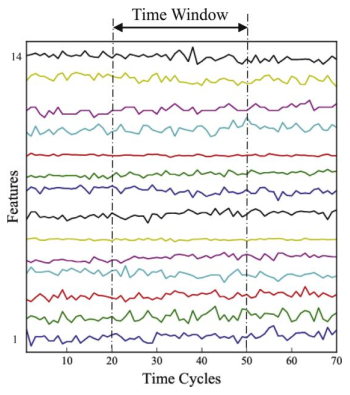









 DownLoad:
DownLoad:

